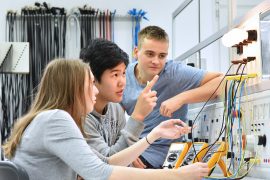“Why is my lecturer a robot now”? This was the question entered into the chat function of Zoom by a student when I first used an AI-assisted avatar of my voice to teach into an undergraduate class in Politics at the University of Sydney. “She’s not a robot, she has a disability,” other students responded to her in the chat function. “I’m an Associate Professor in your Department with a voice disability” I said, via the “Anna Boucher Avatar”, in a voice that sounds like a slightly older, robotic version of me. The student was mortified and wrote a long, kind, apology email to me. But this short exchange was an interesting first foray into working with AI-assisted voice technology.
Background
I live with a voice disability that makes it hard at times to lecture for long periods of time. I have been told by medical experts that the condition is not curable, although I am hopeful that one day they, or I, will find a solution. In the interim, I need to manage the pain and do my job. I had experimented in 2017 and 2018 with short videos constructed in video editing software Camtasia, however this process was time consuming and students, when surveyed, wanted synchronous teaching. Inspired by TedTalk 2019 that featured key speakers with lived experiences of disability, such as DJ Tom Nash, I was determined to find a way to lecture without chronic pain and give the students a synchronous experience. I started researching Stephen Hawking, who famously had ALS (amyotrophic lateral sclerosis) that impacted his speech. He used a now somewhat outdated voice assisted technology in order to speak that was constructed afresh every two years by Intel Corporation.
I decided that if Stephen Hawking could find a solution to his voice, so could I. Working with Jason Markou, Disability Accessibly Lead at the University of Sydney, I researched off-the-shelf text to voice avatars on the market. None of these were very good, most sounded quite robotic (even more so than the Anna Boucher Avatar). Jason also worked with University ICT to attempt to construct an avatar for me, but this was not possible technically. In the end, I found the Scottish company Cereproc (https://www.cereproc.com), world leaders in the development of avatars. This incredible company has used its leading avatars to reconstruct credible unspoken speeches by the assassinated JFK, to help children with voice disabilities in Scotland speak in their own accent rather than an American or British one, and to assist blind children to play Lego.
Development of the Avatar for university-level teaching
Cereproc’s avatars have never been used for University teaching before my intervention, making this a world first. Yet, it’s clear that the potential is significant to use these avatars at a tertiary level. I spent many months reading newspaper articles into a microphone provided by Cereproc, until they recorded my voice accurately. The team at Cereproc then provided me with a download of my voice avatar that I could install on my computer. Using a program called “GhostReader” I can select the “Anna Boucher Avatar” and have it read the text aloud. The avatar reads the lecture as a full script, so I must stop it to toggle between slides. I use Zoom with the computer audio enabled and two monitors to deliver my lectures. I share my PowerPoint slides on one screen, and on the other, I use Ghostreader to read aloud the pre-typed lecture script.
The teaching experience with the Avatar
My first teaching experience with the Avatar was a little clunky, but better than I expected. The Avatar read the lecture that I had typed seamlessly, although we did need to update a few words with Cereproc and remove several robotic “squeaks” in my Avatar voice. At one point, some students said the Avatar was too fast, so I could simply toggled via GhostReader the speed at which it was speaking. Perhaps the biggest advantage with the Avatar is that it allowed me to multitask in a way I had not envisaged. On average, I calculate 3-4 minutes of speech per slide for a lecture. As the Avatar was reading for me, I could use those 3-4 minutes to answer questions in the chat function and provide a more interactive experience to the students than lecturing alone. This is a significant advantage over standard lecturing that makes concurrent lecturing and question answering virtually impossible unless there is more than one academic present. The majority of students, when surveyed via Qualtrics, appreciated the use of the chat function in addition to standard lecturing.
A video recording of the first lecture given by Anna using the Avatar. While the Avatar read the prepared lecture script, Anna was able to answer questions in Zoom chat about both it and the lecture content. This led to rich discussion both with and between students. As this is an early use of the Avatar some squeaks are present in the audio track.
Second, like many female academics, I have experienced what I perceived to be disfavourable treatment based on my sex while teaching. I have experienced at times qualitative comments in USS feedback about my physical appearance, even about my shoes and horribly, when I was pregnant, my full belly. It is well known and documented in the scholarship that women university teachers are perceived differently than men and more negatively, in a way that is not explained by varying competencies in teaching and controlling for other non-gender based variables. Further, I am often viewed as younger than I actually am (sometimes over a full decade younger). This visual appearance can undermine my authority in the eyes of some students, as my credentials and experience are under-recognised relative to my actual age and accompanying experience. When using the Avatar, nobody can see me; the students can only hear me and at that, a slightly robotic version of me in a deeper pitch than my general pitch and tone. When surveyed after the lecture via Qualtrics, the majority of students, thought I was either my age or older. And some did not know my gender. My work here in challenging stereotypes through the use of AI is consistent with Cereproc’s revolutionary work on using its technology to develop gender non-binary voices for the consultancy agency Accenture in order to challenge gender stereotypes in AI itself. It is possible that employing avatars strategically may liberate those academics who experience gender, age and racial discrimination in teaching, to shape shift in a way that focuses on their expertise and contributions to learning, rather than otherwise immovable aspects of their appearance. It might even be interesting to “toggle” to a different voice and see if this impacts student participation or engagement in different ways. Or one might use a non-binary voice like that developed by Accenture and see how this impacts perceptions of teaching and learning and whether this removes a focus on performative gender and power in the classroom.
Moving forward with the Avatar
After the first lecture, Cereproc and I worked on further refining the Avatar’s pronunciation of certain words. Moving forward, I am interested to see how this Avatar can be used in other lecturing settings. I imagine it (the Avatar) will struggle to explain some things such as interactive maps, or statistics, more than others, such as blocks of text, and this is something I wish to explore. While my personal IP (my voice), provision of the Avatar on a trial basis to other staff or students with voice disabilities is also a future direction and Dr Chris Pepin Neff, Diversity and Social Inclusion Coordinator for the School of Social and Political Sciences is currently surveying staff on the prevalence of these health challenges. It is also possible that the Avatar could be useful for students who have very high levels of written communication but struggle with verbal communication and therefore feel they are treated unfairly in assessments requiring class participation. Opportunities that the Avatar presents will be explored in future workshops and meetings across the University including with the Disability At Work Network, on Global Accessibility Awareness Day and on the Central Education Committee as a contribution to lecture innovation at the University. If you would like to be part of future work with the Avatar or to offer opinions and insights on this article, please contact me at [email protected]
I would like to extend credit for the production of this article to Jason Markou, Digital Accessibility Lead, and Alix Thoeming, Lecturer in Academic Development, both at the University of Sydney.
Associate Professor Anna Boucher is an academic in public policy and political science in the Department of Government and International Relations. She is an applied commentator on immigration and labour market issues, having written three books on the topic, most recently with Oxford University Press.
Want to know more?
- Join an online panel event on Global Accessibility Awareness Day, 19 May 2022, discussing the development of Anna’s Avatar and other ways in which assistive technologies both support and enhance learning.
- The Australian Network on Disability have partnered with the University of Sydney to offer training that explores and discusses disability in various teaching, learning, and working contexts. Search for ‘Disability Confident Workforces’ to find the training options available.
- The Modular Professional Learning Framework offers a number of modules that assist in supporting students and staff with diverse learning needs. M03 Inclusion and Diversity specifically addresses this through a Universal Design for Learning framework.





